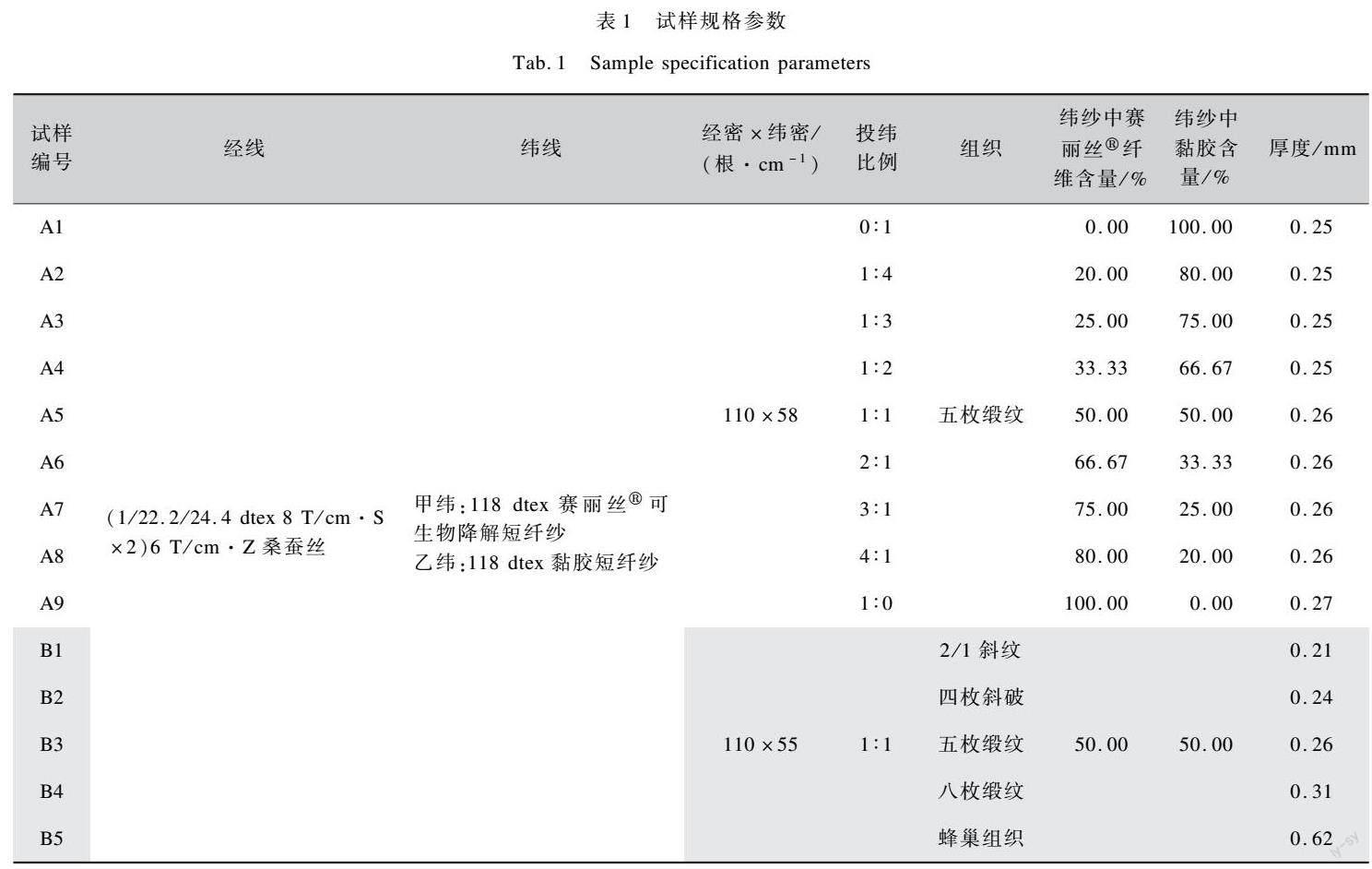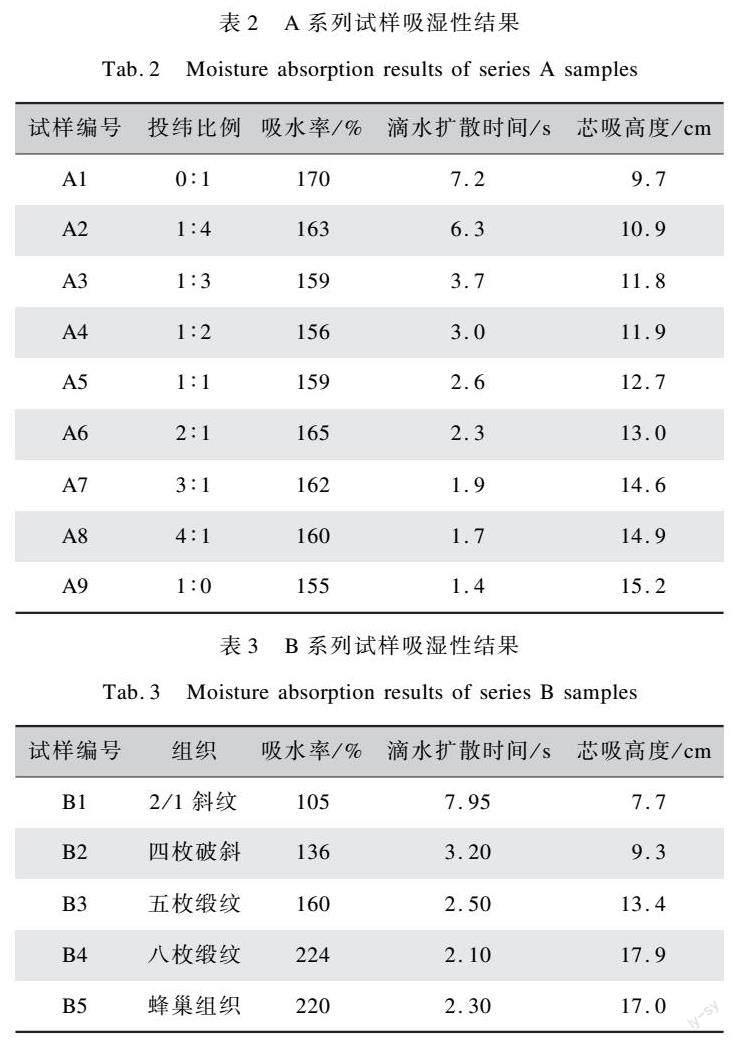吸湿速干与易去污功能性面料的研究
2023-06-19虞旭栋王国夫曲艺郭玲玲祝成炎张红霞
虞旭栋 王国夫 曲艺 郭玲玲 祝成炎 张红霞



摘要: 为研究纬纱中不同的赛丽丝可生物降解纤维含量和组织变化对织物吸湿速干及易去污功能的影响,本文以真丝为经纱,赛丽丝纱和黏胶纱为纬纱,分别试织了投纬比例与织物组织不同的A、B系列的试样。对14种试样进行吸湿速干和易去污功能测试,结果显示:除吸水率与透湿率外,A系列试样的吸湿速干性能随着纬纱中赛丽丝可生物降解纤维的含量增大而逐渐提升。B系列织物吸湿速干性能整体随着组织浮长线变长而变优。纬纱中赛丽丝可生物降解纤维含量愈大,织物的易去污性能愈好。组织表面较平的织物易去污性能更佳。根据模糊综合评价法可知,A系列中投纬比例为4︰1时,试样的吸湿速干与易去污综合性能最优。B系列中组织为八枚缎纹的试样,其吸湿速干与易去污综合性能最优。
关键词: 吸湿速干;易去污;赛丽丝;可生物降解纤维;织物组织;模糊综合评价
中图分类号: TS155.6
文献标志码: A
人体在运动后会大量出汗,为避免产生闷热与黏附感,服装采用吸湿速干的面料可以使汗液被快速吸收转移,从而保持肌肤的干爽舒适[1]。同时人们在日常生活中穿着的服装,尤其是部分合成纤维织物特别容易沾染污垢,又因其表面的亲油性,造成织物难以洗净,但部分易去污性能的织物可用一般的洗涤方法轻松去除污渍[2]。据悉,实现面料易去污功能大多是靠织物后整理,而面料的吸湿速干功能是依靠对纤维进行物理化学方法的改性以改变其结构性能、织物结构,或与其他纤维合理搭配及使用整理剂处理织物来实现[3],且较多产品功能单一。如采用有机氟整理剂对真丝织物进行易去污处理,让丝绸面料易清洗从而满足消费者需求[4]。美国杜邦的Coolmax纤维截面呈扁平十字形状,赋予纤维及其面料吸湿速干性[5]。
当今,中国已成为纺织品的生产与消费大国,人们生活便捷的同时许多难以降解的纺织品废弃物处理不当造成了环境恶化[6]。可生物降解纤维织造的纺织品恰好可解决此问题[7]。目前,可生物降解纺织纤维分为天然可降解纤维(棉、麻、丝等)、再生可降解纤维(莫代尔、黏胶、牛奶蛋白纤维等)和合成可降解纤维(PLA、PCL、PHA等)[8]。且可生物降解纤维交织物性能优良,如牛奶蛋白与天丝交织物的透气性、顶破强力与尺寸稳定性能良好[9]。PLA/PHBV共混长丝与黏胶长丝交织物具有抑菌和手感光滑的特点[10]。基于上述原因,本文研究一款吸湿速干与易去污相结合的可生物降解型交织物。经纱选取真丝,纬纱选取黏胶短纤纱和赛丽丝可生物降解纤维纺制的短纤纱。探究纬纱中赛丽丝可生物降解纤维含量和组织两个因素对织物吸湿速干及易去污性能的影响。通过织造出纬纱中赛丽丝可生物降解纤维含量不同的织物及组织不同但纬纱材料相同的织物,然后对其进行吸湿速干和易去污性能测试。最终运用模糊综合评判数学模型分析实验结果,选出最优试样规格,为研究环保型功能性纺织品提供理论基础。
1 材料与试样制备
1.1 材 料
本次实验选用的经纱是由1根22.2 dtex和1根24.4 dtex的真丝以600捻/m制成(浙江嘉欣丝绸股份有限公司)。纬纱其中一种是线密度为118 dtex、捻度为91捻/10 cm的赛丽丝短纤纱(紧密赛络纺)(佛山富邑纺织技术有限公司);另一种是线密度为118 dtex、捻度为105捻/10 cm的黏胶短纤纱(紧密赛络纺)(潍坊市裕邦纺织有限公司)。本文所选用的赛丽丝短纤纱中的纤维是一款在聚合过程中加入第三单体改变化学结构以实现可生物降解的聚酯纤维。
1.2 设 备
GeminiSEM500型场发射扫描电镜(德国蔡司公司),FA2204C电子天平(青岛聚创环保集团有限公司),计时器、滴定管、烧杯、三级水、YG(B) 141D型数字式织物厚度仪、YG(B) 871型毛细管效应测定仪(温州市大荣纺织仪器有限公司),YG 601-Ⅰ/Ⅱ型电脑式织物透湿仪(宁波纺织仪器厂),无水氯化钙、透湿杯、硅胶干燥器、吸液滤纸、滴管、玻璃棒、酱油、棉标准贴衬(市售)。
1.3 試样制备
本次实验总共设计A、B两个系列试样。A系列是在试样组织均为五枚缎纹的基础上,纬纱中赛丽丝短纤纱和黏胶纱的投纬比例进行变化。B系列是纬纱均为含量50%赛丽丝短纤纱和50%黏胶纱,但对织物的组织进行改变。具体试样编号和规格参数如表1所示。
2 测试方法
本文重在探究织物的吸湿速干性和易去污性能,所以先对A和B系列布样进行以上两种测试,再对测试结果分析归纳。
2.1 吸湿速干性能与易去污性能测试
吸湿速干性能分为吸湿性和速干性,而吸湿性的指标又分吸水率、滴水扩散时间及芯吸高度,速干性的指标分为水分蒸发速率和透湿率[11]。测试前都将织物按照规定进行24 h温度与湿度的平衡。
2.1.1 吸湿性测试
吸水率采用GB/T 21655.1—2008《纺织品吸湿速干评定第1部分:单项组合试验法》测试,每个样品裁取5块长宽均为110 mm试样,浸湿于三级水中,经过5 min取出试样,之后保持布面平整并竖直悬挂,使试样中的水滴落,当相邻两滴水落下的时间间隔不小于30 s时称重,计算结果取平均值。
滴水扩散时间测试同样依据吸水率使用的国家标准,每个样品裁取5块长宽均为110 mm的试样,平摊于桌面,接着手持滴定管吸取少许三级水,使管口距试样表面不大于10 mm,将0.2 mL水滴于试样上。记下水在试样表面完全扩散的耗时,最后取平均耗时。
芯吸高度测试根据FZ/T 01071—2008《纺织品毛细效应试验方法》,沿着每个样品的经向和纬向两个方向,各裁取3块长约250 mm、宽约30 mm的试样,安装在YG(B) 871型毛细管效应测定仪上,使试样下端处于标尺零位下方(15±2) mm,30 min后量取经纬向每块试样渗液最低值。计算各个方向的平均值,结果取经纬向中较大者。
2.1.2 速干性测试
水分蒸发速率与吸水率测试的国家标准相同,立刻称取完成滴水扩散测试的试样质量,之后将试样保持表面平整并竖直悬挂于标准大气中,每3 min称重并记录,当相邻两次的质量变化率不高于1%,终止实验。
透湿率按照GB/T 12704.1—2009《纺织品织物透湿性试验方法第1部分:吸湿法》进行测试。每个样品准备三块半径为35 mm的试样,将其与无水氯化钙及透湿杯按要求装成透湿用组合体,之后将组合体放进按规定调整好温湿度的YG 601-Ⅰ/Ⅱ型电脑式织物透湿仪内,1 h后取出组合体并盖好杯盖,干燥0.5 h后称重,接着轻晃组合体,目的是避免杯中最上层干燥剂因长期使用而效果减小。最后去掉组合体杯盖,放入透湿仪中再重复之前的实验操作。
2.1.3 易去污性能测试
根据FZ/T 01118—2012《纺织品防污性能的检测和评价易去污性》的擦拭法进行测试。先将滤纸垫在平铺的布样下,然后用滴管将满足GB/T 18186—2000《酿造酱油》的约0.5 mL高盐稀态发酵酱油滴于布样上,接着使用玻璃棒将滴液均匀涂在半径为5 mm的圆内,之后让布样平摊干燥。用色卡评判沾污部分和未沾污部分的初始色差,而后用带液率85%±3%的棉贴衬往一个方向擦拭布样上的沾污部分,棉贴衬每擦拭一次都需换到干净的部分接着擦拭,共30次。最后用色卡评判被擦拭部分与未沾污部分的色差。
2.2 赛丽丝纤维在自然土壤中的降解程度测试
因赛丽丝可生物降解纤维已通过国标中可生物降解的堆肥实验,但在土壤中降解效果未知,所以笔者将1 g赛丽丝短纤纱和1 g普通涤纶纱线埋入校园树林的土壤中3个月,然后用GeminiSEM500型场发射扫描电镜观察赛丽丝可生物降解纤维和涤纶纤维的降解程度。
3 測试结果分析
3.1 吸湿速干性能分析
3.1.1 吸湿性分析
吸湿性是用来评判织物本身吸取水的能力,织物吸水越多,吸湿性越强[12]。吸水率是指试样完全湿润后取出,当其处于无滴水状态时吸收的水分质量,与试样干重的比值。从表2、表3可发现,A系列试样的吸水率较B系列的吸水率总体变化不明显,但试样吸水率都超过标准100%,表明该功能性纱线的吸水性良好。这是由于赛丽丝可生物降解纤维含有的亲水基团使纤维自身吸湿能力提高。滴水扩散时间指水滴从触碰试样表面,到完全扩散并渗入试样的时间。A系列试样的滴水扩散时间呈现出随着纬纱中赛丽丝可生物降解纤维含量的增加而减少的现象。除A1和A2滴水扩散时间未能达到5 s以内,其余均达标。因为赛丽丝可生物降解纤维的亲水基团与孔隙结构,使试样的吸湿性与导湿性变优。芯吸高度是指垂直悬挂并一端浸湿在水中的试样,水在一定时间内通过毛细作用沿试样上升的高度。按照织物吸湿速干的国家标准,芯吸高度需不低于90 mm,芯吸高度越大,织物导湿性越好。由表2可知,A1~A9均符合标准,并且当纬纱中赛丽丝短纤纱含量最多时,芯吸高度最大。这主要是因为赛丽丝可生物降解纤维具有孔隙结构,使纤维的比表面积增大,毛细效应得到提高,加快了对水的运输。
由表3可知,B系列中吸湿性能排列为B4>B5>B3>B2>B1,组织为八枚缎纹的织物,其吸水率、滴水扩散时间与芯吸高度结果最佳。结果表明,当纱线材料、投纬比与经纬密一定时,完全组织愈大浮长线愈长,织物吸湿性能愈好[13]。
3.1.2 速干性分析
速干性指的是织物排出水分的能力,水分排出越多,速干性越强[12]。蒸发速率是指做完滴水扩散实验后的试样,在单位时间内蒸发水分的质量。如表4所示,A系列试样的蒸发速率均不低于标准0.18 g/h,且蒸发速率整体上随着纬纱赛丽丝可生物降解纤维含量的升高而增大,由于赛丽丝可生物降解纤维自身的孔隙增加了纤维的比表面积,水分蒸发面积变大,所以织物中添加赛丽丝短纤纱可使织物水分蒸发速率加快。透湿率是指在一定温湿度条件下,规定时间中通过单位面积试样的水蒸气质量。A系列中,透湿率的测试结果接近,说明透湿性与赛丽丝短纤纱含量的关联性小。
结合表1和表5可发现,B系列中八枚缎纹蒸发速率较大,2/1斜纹较小。因2/1斜纹浮长线短,纱线之间的缝隙小,即使织物厚度薄,蒸发速率也会受到影响。虽然蜂巢组织的织物表面不平,与空气接触面积相对较大,但其厚度偏大,所以蒸发速率也较小。B系列中,织物透湿量最好的是八枚缎纹,当纱线材料、投纬比与经纬密一定时,完全组织偏大,浮长线偏长,织物透湿率偏高。由于纱线之间的缝隙增加,水分更容易透过织物。
3.2 易去污分析
按易去污擦拭法对测试结果评价,当擦拭前的初始色差不高于3级时,擦拭后色差级数在3~4级及以上,则该织物具有易去污性。由图1可知,A系列擦拭后的色差级数随着赛丽丝可生物降解纤维的增加而升高。因赛丽丝可生物降解纤维的亲水基团与孔隙结构使其亲水性优异,所以当试样遇水时,赛丽丝可生物降解纤维与水相互作用,纤维/水相的界面张力弱,油污/纤维相的界面张力强,通过外界机械作用使污垢与试样容易分离。由图2可知,B系列中五种组织不同的织物,均达到易去污功能织物的要求。但是表面平整的试样易去污性能更好,表面凹凸的蜂巢组织试样的易去污性能较其他四种偏弱。因为蜂巢组织的织物表面不平易藏污,且用擦拭法擦拭时,很难擦拭到织物所有沾污的部分。
3.3 赛丽丝纤维在自然土壤中的降解程度分析
由图3(a)(b)可知,赛丽丝可生物降解纤维土埋后与土埋前相比,土埋后3个月的纤维表层已逐渐脱落。观察图3(c)(d),普通涤纶纤维土埋后与土埋前相比,变化不明显。虽然赛丽丝可生物降解纤维在土壤中3个月未完全降解,但是与普通涤纶纤维相比,其有较显著的降解趋势。
4 综合评判
因为要筛选出每个系列中性能组合最佳的试样,考虑到检测了试样的多项性能,所以本文采用模糊综合评判的数据处理方式,对A、B系列试样的测试结果进行综合分析。模糊综合评判是以模糊数学为基础的综合评价方法,可以对受到多种因素影响的对象做出一个全面评价[14],优点是能把评判从定性转为定量处理。本文以B系列5块试样为例进行分析。
4.1 确立评价对象的因素集与评价集
4.3 确定评价因素的权重集C
通过查阅有关模糊数学评价面料性能的参考文献,以及对从事纺织人员进行有关吸湿速干和易去污性能重要程度的问卷调查,并根据计算最终确定权重集C={吸水率权重系数、滴水扩散时间权重系数、芯吸高度权重系数、蒸发速率权重系数、透湿率权重系数、初始色差级数权重系数、擦拭后色差级数权重系数}={0.126,0.072,0.120,0.096,0.186,0.120,0.280}。
4.4 构建模糊综合评价模型
将模糊关系矩阵R与权重集C合成模糊综合评价矩阵D,如下式所示。
D=C·R(4)
通过式(4)可得模糊综合评价矩阵D=(0.280,0.469,0.610,0.880,0.409)。根据以上分析结果可知,试样B4是B系列中性能组合最佳的。
同理可知,A系列中性能组合最好的是A8。
5 结 论
本文采用真丝、黏胶与赛丽丝可生物降解聚酯纤维开发一款吸湿速干兼易去污的环保面料,在满足消费者对功能性织物需求的同时解决含普通涤纶织物降解性差的问题。实验通过控制纬纱中功能性纤维的含量与织物组织变化,得出结论:
1) 当纬纱中赛丽丝可生物降解纤维的含量变化,其他织物参数相同时,随着赛丽丝可生物降解纤维含量增加,试样的滴水扩散时间减少,芯吸高度与蒸发速率在增大。吸水率和透湿率虽变化不明显,但也全都达到织物吸湿速干的国家标准。根据模糊综合评判可知,当织物组织变化,其他织物参数一样时,八枚缎纹的吸湿速干性能最佳。
2) 织物的易去污性能随纬纱中赛丽丝可生物降解纤维的含量升高而变佳,且组织表面平整的织物比组织表面凹凸的织物易去污效果好。
《丝绸》官网下载
中国知网下载
参考文献:
[1]王志辉, 魏取福. 抗紫外吸湿排汗户外运动服装面料的现状及发展趋势[J]. 染整技术, 2021, 43(6): 1-4.
WANG Zhihui. WEI Qufu. Present situation and development trend of outdoor sports clothing fabric with anti-ultraviolet and moisture wicking functions[J]. Textile Dyeing and Finishing Journal, 2021, 43(6): 1-4.
[2]赵晓伟. 纺织品易去污性能的测试方法[J]. 印染, 2012, 38(10): 36-38.
ZHAO Xiaowei. Testing method for soil release properties of textiles[J]. China Dyeing & Finishing, 2012, 38(10): 36-38.
[3]邹菲. 功能性面料吸湿速干性能的检测方法与设计分析[J]. 纺织检测与标准, 2020, 6(3): 10-15.
ZOU Fei. Analysis on the testing methods and designs of hygroscopic and quick-drying properties of functional fabrics[J]. Textile Testing and Standard, 2020, 6(3): 10-15.
[4]钱士明, 吴岚. 真丝绸易去污整理技术研究[J]. 丝绸, 2008(12): 36-38.
QIAN Shiming, WU Lan. Study on soil-release finish for silk[J]. Journal of Silk, 2008(12): 36-38.
[5]GORJI M, BAGHERZADEH R. Moisture management behaviors of high wicking fabrics composed of profiled fibres[J]. Indian Journal of Fiber & Textile Research, 2016, 41(3): 318-324.
[6]陳亚精, 陈琦栋, 郑建华, 等. 纺织材料生物降解性能及标准研究进展[J]. 化纤与纺织技术, 2020, 49(1): 31-37.
CHEN Yajing, CHEN Qidong, ZHENG Jianhua, et al. Progress in research of biodegradability and standard of textile materials[J]. Chemical Fiber & Textile Technology, 2020, 49(1): 31-37.
[7]ZENGS H, DUAN P P, SHEN M X, el al. Preparation and degradation mechanisms of biodegradable polymer: A review[J]. IOP Conference Series: Materials Science and Engineering, 2016, 137(1): 012003.
[8]洪巖, 包惠颖, 吴波. 生物可降解材料在服装行业的应用现状及发展趋势[J]. 服装学报, 2022, 7(2): 95-100.
HONG Yan, BAO Huiying, WU Bo. Application status and development trend of biodegradable materials in clothing industry[J]. Journal of Clothing Research, 2022, 7(2): 95-100.
[9]王蝶, 林少见, 沈兰萍. 牛奶蛋白纤维交织物服用性能测试与分析[J]. 国际纺织导报, 2010, 38(11): 50-52.
WANG Die, LIN Shaojian, SHEN Lanping. The test and analysis of wearability for the milk protein interwoven fabric[J]. Meliand China, 2010, 38(11): 50-52.
[10]王华清, 姚禹国. PLA/PHBV/粘胶交织物的前处理工艺[J]. 印染, 2019, 45(24): 22-26.
WANG Huaqing, YAO Yuguo. Pretreatment of PLA/PHBV/viscose interwoven fabric[J]. China Dyeing & Finishing, 2019, 45(24): 22-26.
[11]刘昀庭, 张红霞, 贺荣, 等. 导水型再生涤纶织物的制备及其性能[J]. 纺织学报, 2016, 37(4): 96-100.
LIU Yunting, ZHANG Hongxia, HE Rong, et al. Preparation and performance of moisture wicking recycled polyester fabric[J]. Journal of Textile Research, 2016, 37(4): 96-100.
[12]蒋佳怡, 张红霞, 祝成炎, 等. 吸湿快干抗菌真丝交织物的性能研究[J]. 丝绸, 2021, 58(6): 15-19.
JIANG Jiayi, ZHANG Hongxia, ZHU Chenyan, et al. Research on the properties of hygroscopic and quick-drying antibacterial silk intertextures[J]. Journal of Silk, 2021, 58(6): 15-19.
[13]陈丽华. 组织结构对吸湿排汗织物性能的影响[J]. 棉纺织技术, 2007(5): 5-8.
CHEN Lihua. Influence of stitch structure on properties of moisture absorption and sweat releasing fabric[J]. Cotton Textile Technology, 2007(5): 5-8.
[14]彭张林, 张强, 杨善林. 综合评价理论与方法研究综述[J]. 中国管理科学, 2015, 23(增1): 245-256.
PENG Zhanglin, ZHANG Qiang, YANG Shanlin. Overview of comprehensive evaluation theory and methodology[J]. Chinese Journal of Management Science, 2015, 23(S1): 245-256.
Abstract: With the progress of science and technology, functional fabrics have been gradually developed. There are moisture absorbing and quick drying fabrics that can speed up the transfer of sweat to the outside world and keep skin dry, fabrics with stains being easily removed, far infrared fabrics with medical care function, etc. However, single-function textiles can no longer meet consumer demand due to the improvement of peoples economic level. At the same time, many textile wastes that are difficult to degrade cause environmental pollution due to improper treatment. Therefore, multi-functional and environment-friendly textiles will become the development trend in the future. The purpose of this paper is to study a biodegradable mixed fabric with moisture absorption, quick drying and easy decontaminate properties, so as to meet the demand of consumers for multifunctional fabrics and reduce environmental pollution at the same time.
In the paper, we selected a biodegradable fiber named CELYS. It is a modified polyester fiber with hydrophilic groups and pore structure. So, CELYS biodegradable fiber has excellent moisture absorption and quick drying properties. At the same time, we also used two biodegradable materials, silk and viscose to weave the samples of series A and series B. Pure silk was used as the warp yarn, and CELYS biodegradable staple yarn and viscose staple yarn as weft yarn for all the samples in Series A. The CELYS biodegradable staple yarn and viscose staple yarn were woven in a ratio of “0︰1, 1︰4, 1︰3, 1︰2, 1︰1, 2︰1, 3︰1, 4︰1, 1︰0” for nine samples. Moreover, the fabric weaves of the nine samples were all five-heddle weft satin. Through series A, we mainly explored the influence of the content of CELYS biodegradable polyester fiber in the weft yarn on the moisture absorption, quick drying and easy decontamination properties of the sample. There were five samples in series B, and the warp and weft yarn materials were the same as those in series A. But the CELYS biodegradable staple yarn and viscose staple yarn were woven in 1︰1 ratio in the weft, and the fabric weaves of the five samples were 2/1 twill, four-heddle broken twill, five-heddle weft satin, eight-heddle weft satin and honeycomb weave. Through series B, we mainly explored the influence of different fabric weaves on the moisture absorption, quick drying and easy decontamination properties of the samples. We mainly tested the moisture absorption, quick drying and easy decontamination functions of the samples. Seven indexes including the water absorption rate, drip diffusion time, wicking height, water evaporation rate, water-vapour transmission rate, initial color difference grade and color difference grade after wiping were used to evaluate the strength of the samples moisture absorption, quick drying and easy decontantion properties. In addition, although the CELYS biodegradable polyester fiber has passed GB/T 19277.1—2011 Determination of the Ultimate Aerobic Biodegradability of Plastic Materials under Controlled Composing Conditions—Methods by Analysis of Evolved Carbon Dioxide—Part 1: General Method, its degradation in natural soils is unknown. Therefore, we conducted a three-month natural soil landfill degradation experiment on CELYS staple yarn and common polyester yarn. The surface state of the fiber before and after landfilling was compared by electron microscope observation, and then the degradation status was determined.
According to the analysis of experimental data, in series A, except the water absorption rate and water-vapour transmission rate, the moisture absorption and quick drying properties of the sample become better with the increase of CELYS biodegradable fiber content in the weft. And the higher the content of CELYS biodegradable fiber in the weft, the stronger the easy decontamination performance of the samples. In series B, compared with the samples of other fabric weaves, the eight-heddle weft satin sample has the best moisture absorption and quick drying performance. In the aspect of easy decontamination performance, except the honeycomb weave samples with low easy decontaminate performance, other fabric weave samples exhibit similar easy decontamination performance. It is found by the fuzzy comprehensive evaluation method that the sample with a 4︰1 weft ratio of CELYS staple yarn to viscose staple yarn in series A has the best comprehensive performance of moisture absorption, quick drying and easy decontamination. In series B, the sample with eight-heddle weft satin has the best comprehensive performance of moisture absorption, quick drying and easy decontamination. In addition, the results of natural soil landfill experiment show that the CELYS biodegradable polyester fiber reveals a significant degradation trend compared to ordinary polyester fibers.
To sum up, we design and weave a series of samples with biodegradable fibers as the raw material, change the functional yarn content or weaves of the fabrics, test their moisture absorption, quick drying and easy decontamination performance, and adopt the comprehensive evaluation method of fuzzy mathematics to select the optimal specification parameters of the samples. The scheme can provide reference for the development of multi-functional environmental friendly fabrics.
Key words: moisture absorption and quick drying; easy decontamination; CELYS; biodegradable fiber; fabric weaves; fuzzy comprehensive evaluation
